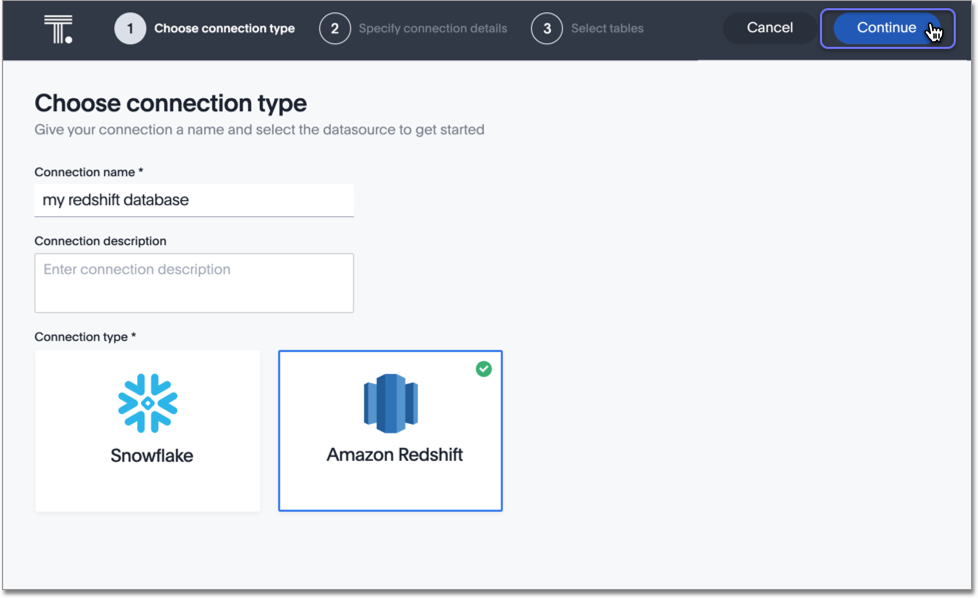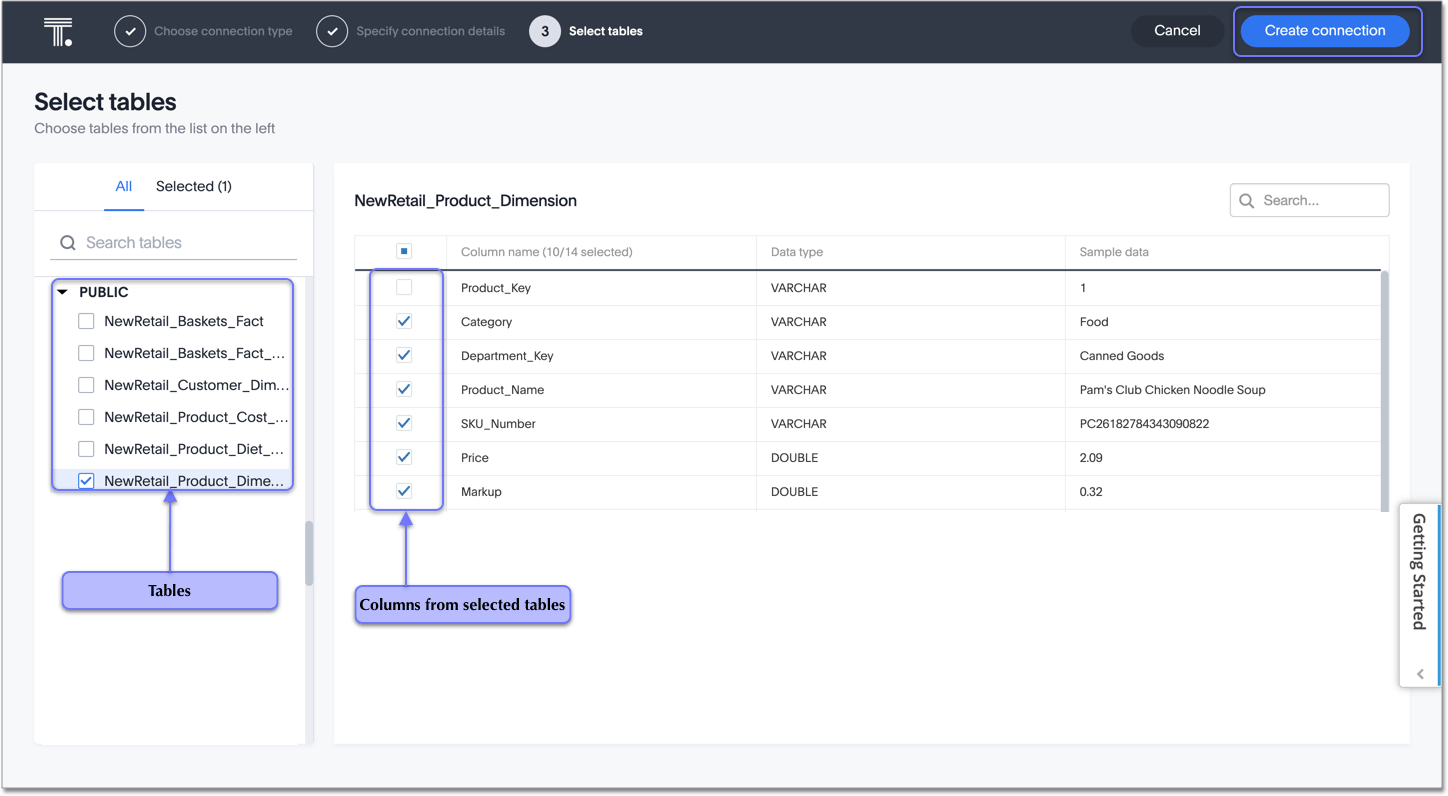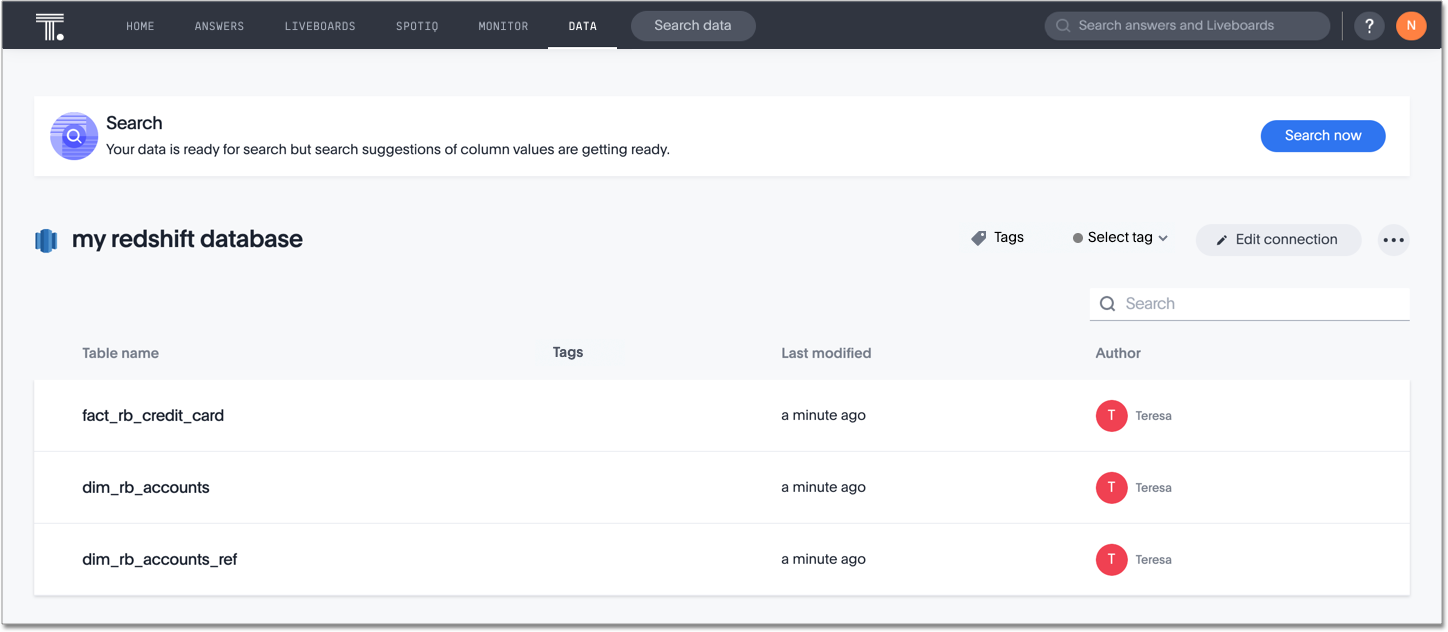Add a Redshift connection
Before you begin
If you are going to use SSL, you must configure it before you can add a Redshift connection.
Enabling SSL in Redshift
If you need to create a secure connection to Amazon Redshift, you must edit the "parameter group" assigned to your Redshift cluster and enable the require_SSL flag.
To enable FIPS-compliant SSL mode, set both the use_fips_ssl parameter and the require_SSL parameter to true in the parameter group that is associated with your Redshift cluster.
For more information, see Connect using SSL in Amazon’s Redshift documentation.
Adding a Redshift connection
To connect to Amazon Redshift:
-
Select Data in the top navigation bar.
-
Open the Connections tab in the left navigation bar, and select the Redshift tile. Alternatively, select + Create new in the left navigation bar, select Connection, and select the Redshift tile.
-
Create a name for your connection and a description (optional), then select Continue.

-
Enter the connection details for your Redshift data source using Service Account, IAM, OAuth, or AWS IDC OAuth. The User you specify must have at least read access to the SVV_TABLE_INFO table.

For Service Account authentication, do the following:
-
Enter Host, Port, User, Password, and Database.
For IAM authentication, do the following:
-
Enter Host, Port, Database, Db User, Access Key, and Secret Key.
For OAuth authentication, do the following:
-
Enter Host, Port, OAuth Client ID, OAuth Client Secret, Scope, Auth Url, Access token Url, and Database.
For AWS IDC OAuth authentication, do the following:
-
Enter Host, Port, OAuth Client ID, OAuth Client Secret, Scope, Auth Url, Access token Url, AWS Identity Namespace, and Database.
-
-
(Optional) To customize additional JDBC parameters supported by Redshift, use Advanced Config. Refer to the Redshift JDBC documentation.
-
(Optional) If you enabled SSL in your Redshift cluster, you must do the following:
-
Select the Advanced Config menu to reveal the Key and Value fields.
-
For Key, enter SSL.
-
For Value, enter True.
To add more keys and values, select the plus sign (+), and enter them.
Any key-value pairs that you enter must be defined in your Redshift data source. Key-value pairs are case-sensitive. -
-
You can add a parameter to list all the databases in your Cloud data warehouse even if you add a specific database name in the Database property. To use this parameter, do the following:
-
Select the Advanced Config menu to reveal the Key and Value fields.
-
For Key, enter databaseMetadataCurrentDbOnly.
-
For Value, enter False.
-
-
Select Continue.
-
Select tables (on the left) and the columns from each table (on the right), and then select Create connection.

A message appears indicating the number of tables and columns that will be added to your connection.
-
Select Create.
Once the connection is added, you can search your Redshift database right away by selecting Search now.

Your new connection appears on the Data > Connections page. You can select the name of your connection to view the tables and columns in your connection.
The connection you just created is a link to the external data source. If there are any joins in the selected tables of the external data source, those are imported into ThoughtSpot.
You can now perform a live query on the selected tables and columns of your connection. Because the selected tables and columns in your connection are linked, it may take a while to initially render the search results. This is because ThoughtSpot does not cache linked data. With linked data, ThoughtSpot queries the external database directly. == Share a connection
Users with can manage data or admin privileges can share connections with other users or groups that have can manage data privileges. Once granted access to a connection, users can add, remove, and modify tables in that connection.
To share a connection with another user, follow these steps:
-
Navigate to the Data tab and select Connections.
-
Select the checkbox next to the name of the connection you want to share, and click Share.
-
In the Share connection dialog, enter the ID of the user or group you want to share the connection with. You can use the search bar to find the user or group.
-
Select Done.
Note that to remove share access from a connection, you must navigate to the Share connection dialog and select Remove access to the left of the user group or name.




Show content